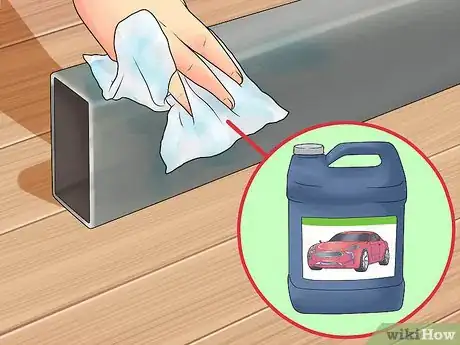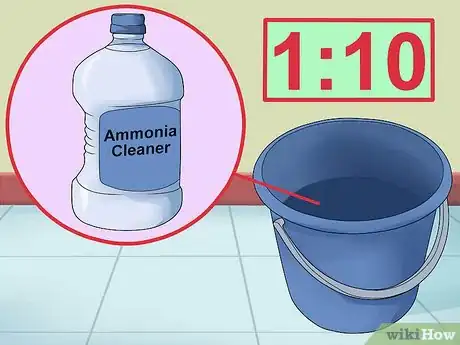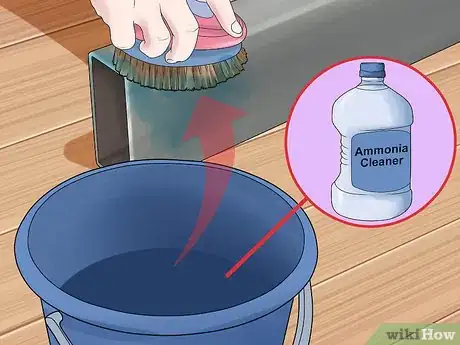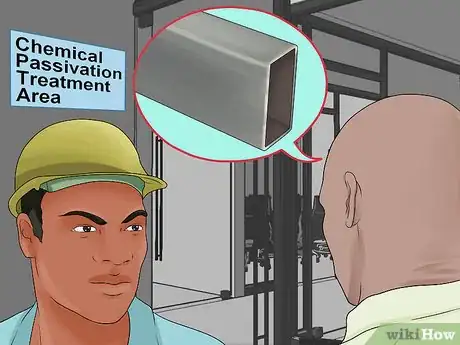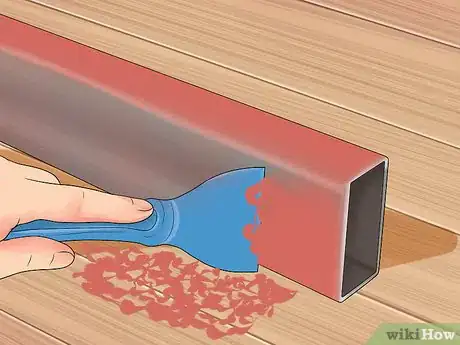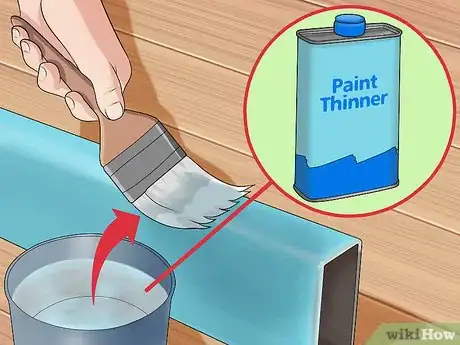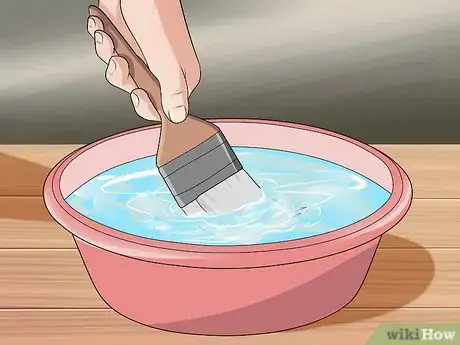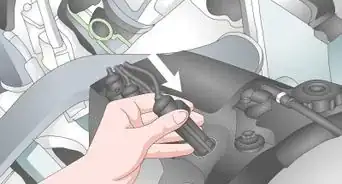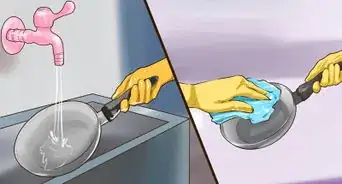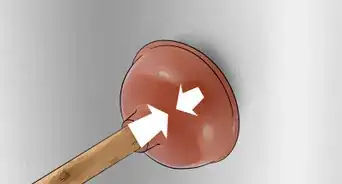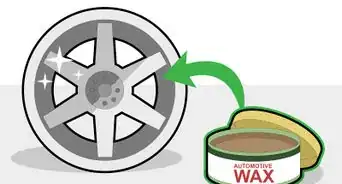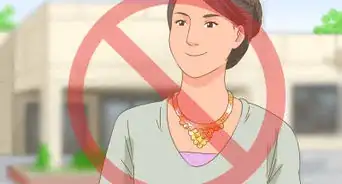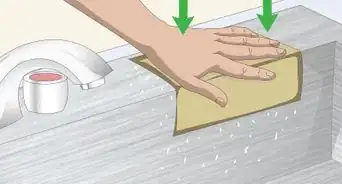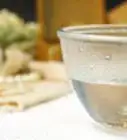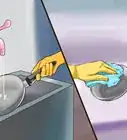This article was co-authored by wikiHow Staff. Our trained team of editors and researchers validate articles for accuracy and comprehensiveness. wikiHow's Content Management Team carefully monitors the work from our editorial staff to ensure that each article is backed by trusted research and meets our high quality standards.
There are 9 references cited in this article, which can be found at the bottom of the page.
This article has been viewed 247,212 times.
Learn more...
Galvanized steel is steel that has a tightly bonded zinc coating that prevents corrosion and increases the steel's longevity and durability.[1] Galvanized steel can often be found in sheet metal, gutters, and car doors and hoods.[2] While galvanized steel remains resistant to rusting, it can still get dirty and should be handled with care. If you take care of your galvanized steel and clean it regularly, you can increase its longevity and maintain its appearance for a long time.
Steps
Cleaning Off Dirt and Mud
-
1Wipe down your galvanized steel with a damp rag. An initial cleaning with a rag dipped in fresh water will remove any dirt or streaks on your galvanized steel. Regular maintenance will reduce the amount of dirt and chemical buildup that forms on your steel over time and will make cleaning easier in the future.
-
2Scrub your steel with a brush and a detergent solution. Use a tablespoon (14.79 milliliters) of laundry detergent and mix it into a bucket of water. Make sure to do a thorough scrubbing over the surface of your steel and pay particular attention to problem areas where dirt or mud has built up. Use a nylon or plastic brush because other brushes can interact with the steel and alter its color.
- Do not use harsh cleaners. A cleaner with a pH of more than 12 to 13 can begin to dissolve the zinc in your galvanized steel.[3]
- Washing steel in this way may make areas that you clean look uneven compared to the areas that you don't.
- Abrasive overwashing of your galvanized steel will reduce the steel's lifecycle and wear out the zinc coating. Scrub your galvanized steel sparingly.
Advertisement -
3Use a car wash or truck wash to clean your steel. Truck and car washes are made to reduce the potential for corrosion, and will typically also be well-suited to clean your galvanized steel. Remember to rinse your steel thoroughly with cold water after using the cleaner.
- Make sure to read the back of the car wash for directions and warnings.
- You can pick up car wash at an automotive store, department store, or online.
- Most contemporary cars use galvanized steel to prevent rusting.[4]
-
4Spray your steel with a low-pressure washer for larger areas. If you have a large area of galvanized steel to clean, like a roof or the siding on a building, using a pressure washer will save you time and effort. This is also a way to quickly rinse off any chemicals or cleaners you may have used to clean your steel.
- Make sure that your pressure washer is lower than 1450 psi, or it may remove the coating on your steel.[5]
Removing Wet Storage Spots
-
1Mix one part ammonia to ten parts fresh water in a bucket. You can purchase ammonia cleaning products at most major department stores. Mix the ammonia cleaner and the water into a bucket and use the solution to clean your galvanized steel.
-
2Dip a durable nylon brush into the solution and wipe down your steel. Dip a nylon brush into the solution and scrub down your steel using a circular motion. Make sure to pay attention to problem areas. The white substance should start to come off as you clean.
-
3Request the use of chemical passivating treatments. The steel manufacturer may be able to provide these treatments to you at a cost. Chemical passivating reduces the likelihood of wet storage spots or "white rust" from appearing on your steel. The process covers the steel with a thin layer of water-based chromate coating, which can further protect it from being affected by the environment.[8]
- Spending the extra money passivating your steel may save you money in the long run because you won't have to pay for replacement steel.
-
4Rinse your steel with water and allow it to dry thoroughly. Use fresh water when rinsing your galvanized steel. Any chemicals that remain on its surface may corrode or destroy steel's coating over time.
-
5Avoid storing your steel in damp or poorly ventilated areas. Improperly storing your steel can create wet storage stains on them. Instead of stacking your steel, make sure that you put it on an angle so it can properly drain if it gets wet. Accumulation of water over time can create zinc deposits that form on the top of your steel.[9]
Cleaning off Paint
-
1Scrape the initial paint off with a wooden or plastic scraper. Do not use a metal scraping device to get paint off galvanized steel because it can easily scratch it and ruin its surface. Work your way around and remove the paint in large chunks, then concentrate on the smaller pieces next. Don't worry about getting it all, because you will be using a chemical process to eliminate the rest of the paint.
- If the paint is fresh and wet, skip this step and go to step two in this method.
- You can also use sandpaper or a wire brush to remove stuck on paint or rust from your galvanized steel. Be warned that this may cause discoloration, so if you need to maintain your steel aesthetically, these would not be good tools to use.[10]
-
2Scrub new paint with a standard paint thinner. If the paint is fresh, you can use a nylon brush and paint thinner to remove it from your galvanized steel. Add paint thinner to your galvanized metal with a rag and proceed to work it in with your nylon brush.
-
3Wipe your steel with a non-alkaline stripper for hard paint. Paint that has dried and has become hard is harder to remove. Luckily, many paints react poorly with the zinc found in galvanized steel and will peel and chip once dry, making it easier for you to clean.
- Apply your stripper with a rag and scrub it in with a nylon or plastic bristled brush.
-
4Rinse your paint remover thoroughly after washing. Any chemicals left over can change the hue of your steel in the future. Make sure to wash away any remaining residue by running your steel under fresh water.
Community Q&A
-
QuestionI left galvanized sheets together in the rain, now they are black. Is there any way to return them to normal?
 Community AnswerThis is typical of galvanized steel, as it will often become discolored after left to the elements. The black or brown color you describe is purely aesthetic and does not affect the stability of the steel at all. If you don't like the color, you can paint over it.
Community AnswerThis is typical of galvanized steel, as it will often become discolored after left to the elements. The black or brown color you describe is purely aesthetic and does not affect the stability of the steel at all. If you don't like the color, you can paint over it. -
QuestionI have galvanized steel window wells that are no longer silvery shiny. They are a dull grey. Is it possible to get them shiny again by just cleaning them?
 Community AnswerUse white vinegar. Wet a paper towel with white vinegar. Let it sit on the steel for about an hour and see if that has any improvement. It may need to sit longer for the best effect.
Community AnswerUse white vinegar. Wet a paper towel with white vinegar. Let it sit on the steel for about an hour and see if that has any improvement. It may need to sit longer for the best effect.
References
- ↑ http://www.galvanizeit.org/hot-dip-galvanizing/what-is-hot-dip-galvanizing-hdg
- ↑ http://www.gsa.gov/portal/content/111758
- ↑ http://www.paintsquare.com/library/articles/Applicator_Training_Bulletin__Cleaning_and_Painting_Galvanized_Steel.pdf
- ↑ http://www.autoguide.com/auto-news/2015/03/should-you-rust-proof-your-new-car-.html
- ↑ http://www.galvanizeit.org/education-and-resources/resources/technical-faq-dr-galv/cleaning-hot-dip-galvanized-steel
- ↑ https://www.health.ny.gov/environmental/emergency/chemical_terrorism/ammonia_general.htm
- ↑ http://www.galvanizeit.org/education-and-resources/resources/technical-faq-dr-galv/cleaning-hot-dip-galvanized-steel
- ↑ http://www.steelmillsoftheworld.com/activities/datacenter/G_Note7.pdf
- ↑ http://www.galvanizeit.org/specification-and-inspection/post-hdg-considerations/storage
About This Article
To clean dirt or mud off your galvanized steel, wipe down your steel with a damp rag. Then, mix 1 tablespoon of laundry detergent with a bucket of water and scrub your steel with it. If you’re trying to remove wet storage spots, you can make a 1:10 ammonia-water solution. In either case, use a nylon or plastic brush, since other brushes can interact with your steel and change its color. To clean paint, first scrape off what you can with a wooden or plastic scraper. Then, scrub off fresh paint with regular paint thinner or use a non-alkaline stripper on older paint. To learn how to use car- or truck-wash solutions or a chemical passivating treatment to clean your galvanized steel, read on!


